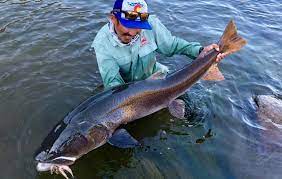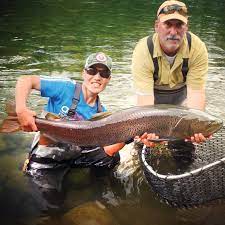This post was last updated on August 28th, 2021 at 02:16 pm
The taimen fish is a species of fish in the salmon family; one of the five species of the genus Hucho. This is a fish with an ancient history. It was once known to achieve lengths of over six and a half feet (two meters) and weights of over two hundred twenty pounds (one hundred kilograms). Recent tracking of the taimen has not rendered many fish over five feet, three inches in length with weights of around a hundred pounds. Taimen choose rivers with fast moving currents to live and spawn. The taimen boasts a life span of twenty to fifty years.

Taimen Fish Facts and Info (Hucho Taimen)
The taimen trout is by far the largest salmonid in the world.
International Union for the Conservation of Nature (IUCN) has determined that the taimen is a critically endangered species. Because of overfishing and loss or pollution of its habitat, the taimen is now at only ten percent of the population seen in Japan, Russia and some other parts of Asia. The densest population of taimen is centered around the Russian island of Sakhalin, with other significant numbers found on Hokkaido in Japan.
Where does the Taimen fish live?
Geographical distribution of the taimen includes rivers in Russia as well as rivers that originate in Russia, yet actually end in Caspian and Arctic drainage systems in Eurasia and in the Pacific drainage in Mongolia.
Taimen Trout Identification
The appearance of the taimen is somewhat influenced by geography and environment, but is mostly found as olive green fading into reddish brown. Fins are usually a darker garnet red. The belly is always pale, either white or gray.
While very long lived, the taimen reaches spawning age at five to seven years of age, a length of twenty seven and a half inches and a weight of around seven pounds. Females can lay approximately thirty thousand eggs, depending on her size. Mature fish spawn in later April or May. Actual spawning time is completely determined by water temperature. Once the spawning season starts, it generally lasts approximately two weeks.
Not much is known about the spawning behavior of the taimen. It is believed that they are largely anadromous. Researchers have found that they may migrate short distances, but they are not given to ocean-run behavior as fish such as the Steelhead. During the spawning season, the taimen will migrate from the deeper rivers to the more shallow streams. They seem to prefer the smaller tributaries that are around 5 feet (slightly less tha 2 meters) or so deep. During the fall season, the taimen will seek out larger and deeper rivers to feed as they are apex predators. Taimen generally migrate no more than one to three miles during their entire life span.
What do Taimen fish eat?
Called “river wolves” as they have been observed hunting in packs, the taimen’s feeding habits are largely dependent on other fish, sometimes quite large fish. They are also known to consume mammals, bats and rodents, a variety of birds, amphibians and reptiles, over fifty kinds of fish and are given to cannibalistic tendencies. A true apex predator, the taimen will eat anything alive that happens to be in the river with them.
Fishing for Taimen trout
In the last two decades, the taimen has become well known as a sport game fish. Fly fishermen, in particular, with their propensity for catch and release practices, frequently seek out the taimen. The use of barbless hooks is mandated in many areas to preserve the ever-shrinking populations.
Farming practices are largely unknown in the geographic areas where the taimen is found, as the indigenous people are generally nomadic by nature. In addition, the taimen possess such a slow growth rate and require such a great amount of time to reach reproductive maturity that farming them would not be a feasible practice. Furthermore, due to the growth and reproductive age factors, they are imminently more valuable as a game fish.
The taimen is occasionally taken, usually illegally, for commercial purposes; it does not fare well at market.
Check out this video about fly fishing for taimen trout
A Threatened Species
The taimen is considered a freshwater megafish, but like many other megafish around the globe, the taimen is threatened with extinction. Between the years 2000 and 2004, scientists completed a four year study of the taimen on the Eg and Uur rivers in Khovsgol, Mongolia. The study involved sixty miles stretches of each river. The study proved that the taimen – sometimes called the Eurasian trout, has become far too rare and endangered to sustain any form of commercial or recreational harvest. Removing even one of these fishes from the population means years of time has to pass before a viable reproductive fish can replace it.
Last Stronghold of the Taimen
The National Geographic Society has instituted a multi-year effort to study and document over twenty species of at-risk endangered freshwater fish around the world. The taimen is included in this group.
This project encompasses singular species that comprise the group known as “megafish”; those that grow at least six feet in length or 220 pounds in weight. Over seventy percent of these species are already on the verge of extinction resulting from pollution, poor resource management and loss of habitat.
The taimen is the only fish in the group, belonging to the trout or salmon genus that grows large enough to be an esteemed member of this elite group. In China, the taimen has already been over fished to the very brink of extinction. Russia, as well, has harvested the taimen to the classification of “greatly at risk”. The last great stronghold of the taimen is Mongolia’s Eg-Uur river system. Being populated by nomadic herdsmen, the population of fishermen is quite small.
With the introduction of outdoor adventure experiences and fishing for recreation, fueled mostly by western travelers and adventurers, poaching of taimen is on the rise.
Taimen Fish Images
Are Taimen fish endangered?
The studies conducted on the taimen have rendered less than promising results. The number of fish tagged by scientists annually is right around one hundred specimens, where they hope to learn more about the fish’s behavioral patterns.
In the Eg-Uur river basin, scientists estimate a population of approximately two thousand taimen of twenty-six inches or more. The telemetric technology that is being utilized is proving that these fish migrate very little during their lifetimes, although there are those rogues who have been tracked as traveling fifty miles or more from their tag sites. Since the taimen is extremely territorial, it makes them predictable and therefore vulnerable to poaching. Once people location a spot on the river holding large fish, they keep coming back until every fish is harvested.
There are adventure guides, mostly based in the U.S., offering the chance to catch and release the biggest salmon on the planet. By law, they must utilize single shank, barbless hooks and the fish must be released unmolested. Taimen are very strong fish and can be caught multiple times without being harmed.
Of course, bringing sport fishing to Mongolia helps to stabilize their economy is a big way. The recently founded Taimen Conservation Fund supports preservation of the taimen and sustainable fishing.
Summary – Taimen Fish (Hucho Taimen)
Scientists and researchers who have been tagging these fish see them living in the same deep holes in the rivers over a period of years. It’s almost as though they have formed a personal bond with the fish, even naming them in some instances. They want to see these fish retain their positions as apex predators, part of the food chain and the life cycle of the earth. Those affiliated with the National Geographic Society’s efforts view their efforts as a chance – perhaps the last chance – to protect the taimen before it disappears forever.
The taimen image (top) is licensed under the Creative Commons Attribution-Share Alike 3.0 Unported license. Attribution: Ojensen en.wikipedia



